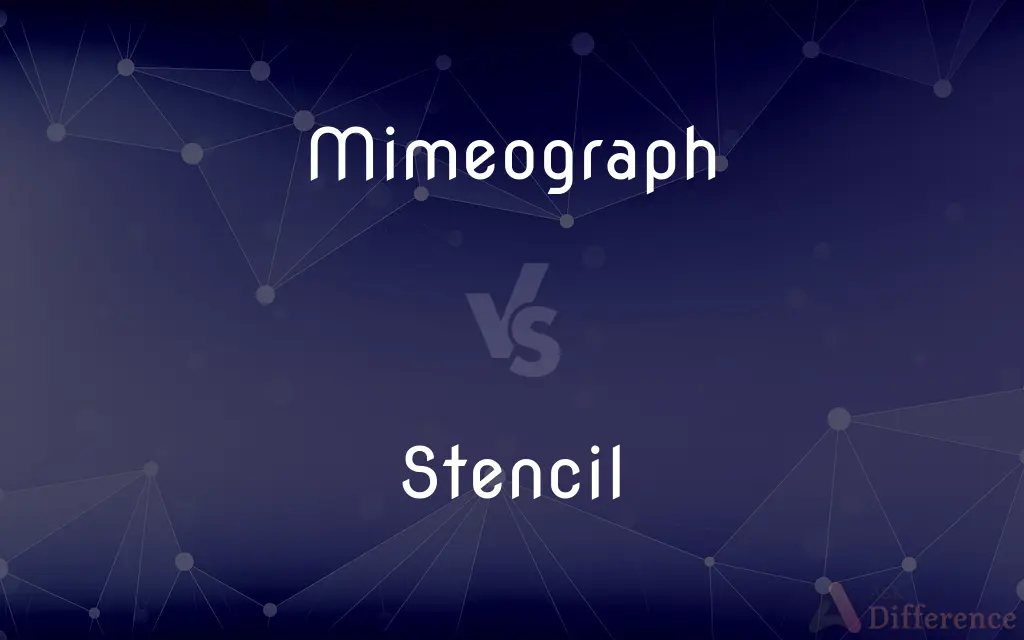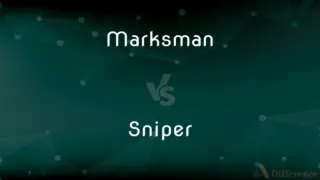Mimeograph vs. Stencil — What's the Difference?
By Tayyaba Rehman & Fiza Rafique — Updated on May 6, 2024
Mimeograph machines produce copies using a stencil on a rotating drum that presses ink through to paper, while a stencil generally refers to a sheet with designs cut out for applying paint or ink to surfaces.

Difference Between Mimeograph and Stencil
Table of Contents
ADVERTISEMENT
Key Differences
A mimeograph is a type of duplicator that uses a stencil made of waxed paper. The text or images are typed or drawn on the stencil, removing the wax and exposing the paper fibers. In contrast, stencils are typically sheets of material like plastic, metal, or paper with patterns or letters cut out, used for painting or drawing multiple instances of the design on various surfaces.
Mimeograph machines work by fitting the prepared stencil around a cylindrical drum filled with ink. As the drum rotates, ink is forced through the exposed areas of the stencil onto paper. Whereas stencils are manually used by applying ink or paint over the sheet to transfer the cut-out design onto the underlying surface.
The mimeograph was widely used for high-volume office printing before the advent of modern printers and copiers. On the other hand, stencils are used in various applications, from street art to home decor, indicating a broader scope of use beyond just document duplication.
One key advantage of mimeographs was their cost-effectiveness in producing large quantities of copies, such as for newsletters or classroom handouts. Stencils, however, are reusable and versatile, suitable for creating artistic patterns and decorations on different materials like walls, fabric, and wood.
Mimeographs required the preparation of a specific type of stencil and could be messy due to the ink involved in the process. In contrast, stencils are generally cleaner and simpler to use, with only the need for paint or a spray can.
ADVERTISEMENT
Comparison Chart
Definition
A duplicator machine using ink and stencils
A template used to draw or paint patterns
Usage
Document duplication
Artistic and decorative applications
Operation
Requires a drum to press ink through stencil
Direct application of paint or ink
Material
Waxed paper stencil
Plastic, metal, paper
Primary Advantage
Economical for large volumes
Reusable and versatile
Compare with Definitions
Mimeograph
A machine that produces copies by forcing ink through a stencil.
The school newsletter was printed on a mimeograph in the 1970s.
Stencil
A template used for reproducing patterns or letters on various surfaces.
The artist created street art using a complex stencil.
Mimeograph
A duplicating machine using ink and a stencil for printing documents.
They used a mimeograph to duplicate exam papers quickly.
Stencil
A tool used in decorative arts to transfer designs.
He applied a stencil to the fabric to make unique t-shirt designs.
Mimeograph
A device for making multiple copies using a manually operated ink-filled drum.
The mimeograph churned out hundreds of flyers for the event.
Stencil
An instrument used to achieve artistic precision and repetition.
Using a stencil, she added uniform stars to the sky in her mural.
Mimeograph
An early form of a copier using a drum and stencil.
Mimeographs were common in offices before photocopiers became widespread.
Stencil
A thin sheet of material with a design cut out, used to apply paint or ink.
She used a stencil to paint a floral pattern on the wall.
Mimeograph
An office machine for printing text from a prepared stencil.
The smell of ink from the mimeograph was a familiar scent in the office.
Stencil
A cut-out used for drawing or spraying images repeatedly.
The stencil made decorating the room quick and easy.
Mimeograph
A mimeograph machine (often abbreviated to mimeo, sometimes called a stencil duplicator) is a low-cost duplicating machine that works by forcing ink through a stencil onto paper. The process is called mimeography, and a copy made by the process is a mimeograph.
Stencil
Stencilling produces an image or pattern by applying pigment to a surface under an intermediate object with designed gaps in it which create the pattern or image by only allowing the pigment to reach some parts of the surface. The stencil is both the resulting image or pattern and the intermediate object; the context in which stencil is used makes clear which meaning is intended.
Mimeograph
A duplicator that makes copies of written, drawn, or typed material from a stencil that is fitted around an inked drum.
Stencil
A sheet, as of plastic or cardboard, in which a desired lettering or design has been cut so that ink or paint applied to the sheet will reproduce the pattern on the surface beneath.
Mimeograph
A copy made by this method of duplication.
Stencil
The lettering or design produced with such a sheet.
Mimeograph
To make (copies) on a mimeograph.
Stencil
The process of printing with such a sheet.
Mimeograph
To use a mimeograph.
Stencil
To mark with a stencil.
Mimeograph
(historical) A machine for making printed copies using typed stencil, eventually superseded by photocopying.
Stencil
To produce by stencil.
Mimeograph
To make mimeograph copies.
Stencil
A thin sheet, either perforated or using some other technique, with which a pattern may be produced upon a surface; a utensil that contains a perforated sheet.
Mimeograph
A copying device that uses a stencil through which ink is pressed; it was invented by Edison.
Stencil
Pattern A pattern produced using such a utensil.
Mimeograph
To make copies of using a mimeograph; as, She mimeographed the syllabus.
Stencil
A two-ply master sheet for use with a mimeograph.
Mimeograph
A rotary duplicator that uses a stencil through which ink is pressed (trade mark Roneo)
Stencil
To print with a stencil.
Mimeograph
Print copies from (a prepared stencil) using a mimeograph;
She mimeographed the syllabus
Stencil
A thin plate of metal, leather, or other material, used in painting, marking, etc. The pattern is cut out of the plate, which is then laid flat on the surface to be marked, and the color brushed over it. Called also stencil plate.
Stencil
To mark, paint, or color in figures with stencils; to form or print by means of a stencil.
Stencil
Device that has a sheet perforated with printing through which ink or paint can pass to create a printed pattern
Stencil
Mark or print with a stencil
Common Curiosities
How does a stencil differ from a mimeograph in terms of application?
Stencils are used for artistic and decorative purposes on various surfaces, whereas mimeographs are primarily used for duplicating text documents.
What is a mimeograph used for?
A mimeograph is used for creating multiple copies of a document through a manual or electric duplicating process.
Can a stencil be used multiple times?
Yes, stencils are designed to be reusable, allowing for multiple applications of the same design.
What type of ink is used in a mimeograph?
Mimeographs use a specific ink that is formulated to dry quickly and adhere to paper through the stencil.
What are the advantages of using a stencil?
Stencils offer versatility and reusability, making them ideal for repeated patterns and artistic projects.
How do mimeographs produce copies?
Mimeographs produce copies by pressing ink through a waxed paper stencil onto paper as the drum rotates.
Is there a size limitation for stencils?
No, stencils can vary greatly in size, from small handheld designs to large sheets for mural painting.
What materials are stencils made from?
Stencils can be made from various materials including paper, plastic, and metal, depending on the intended use.
Can mimeograph stencils be prepared by hand?
Yes, mimeograph stencils can be manually prepared by typing or drawing directly on the stencil paper.
What is the primary use of a mimeograph in educational settings?
Mimeographs were primarily used in schools to duplicate worksheets and informational handouts.
Are mimeographs still in use today?
Mimeographs are largely obsolete and have been replaced by modern digital printers and copiers.
How do stencil designs impact the outcome of an art piece?
Stencil designs contribute to the precision and uniformity of repetitive elements in an artwork.
Can mimeographs handle color duplication?
Mimeographs were primarily designed for black and white duplication, though some models could use different colored inks.
How do artists use stencils?
Artists use stencils to create intricate designs and patterns consistently across various media.
What is the typical lifespan of a mimeograph machine?
Mimeograph machines, if maintained well, could last for many years in an office or school setting.
Share Your Discovery

Previous Comparison
Stall vs. Circle
Next Comparison
Marksman vs. SniperAuthor Spotlight
Written by
Tayyaba RehmanTayyaba Rehman is a distinguished writer, currently serving as a primary contributor to askdifference.com. As a researcher in semantics and etymology, Tayyaba's passion for the complexity of languages and their distinctions has found a perfect home on the platform. Tayyaba delves into the intricacies of language, distinguishing between commonly confused words and phrases, thereby providing clarity for readers worldwide.
Co-written by
Fiza RafiqueFiza Rafique is a skilled content writer at AskDifference.com, where she meticulously refines and enhances written pieces. Drawing from her vast editorial expertise, Fiza ensures clarity, accuracy, and precision in every article. Passionate about language, she continually seeks to elevate the quality of content for readers worldwide.
















































